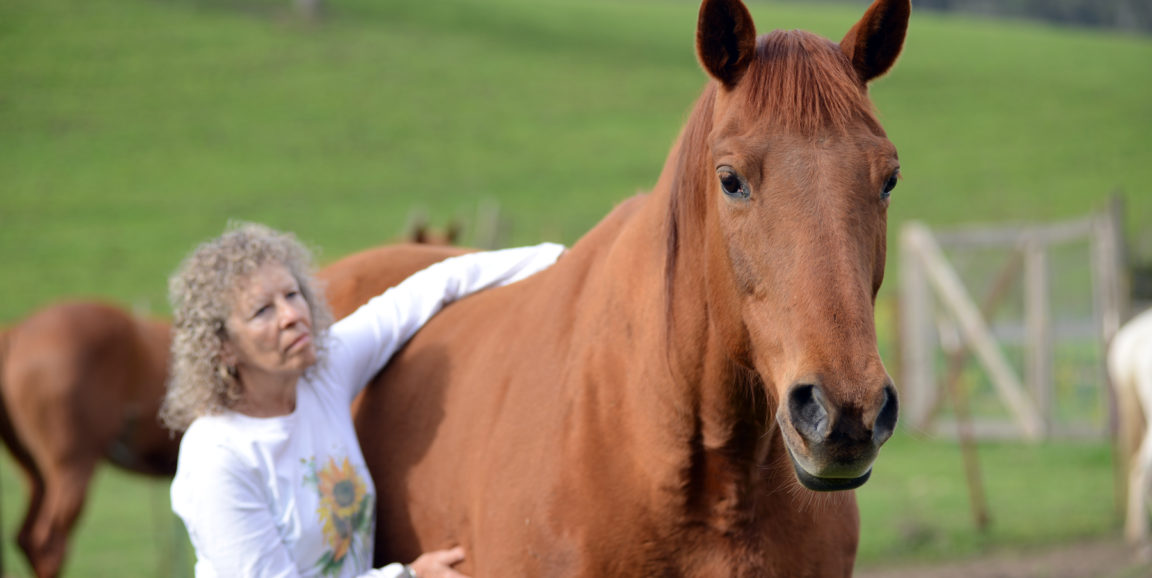It’s a clear, crisp January morning as I head out to the pasture with a bucket of warm oats. I call my horse’s name and, a moment later, hear her galloping towards me thunderously. She greets me with a gentle little nuzzle, looking for the slice of apple she knows is always in my pocket for her. We go through our morning routine of grooming and feeding and, though no words are exchanged, there’s a clear conversation that happens between us.
It wasn’t always this way, though. When I saw my sweet mare, Espresso, for the first time four years ago, it was love at first sight. But without words, it took a long time for me to read her signals and learn to communicate effectively with her. What did it mean when she pinned her ears back for example? (Hint: Back off.) How could I read her body language to know whether she was scared or just feeling frisky? How could I teach her to understand my cues and body language when I led her to the barn?
The journey of learning how to communicate with this large beautiful animal without language, and to build trust in doing so, has been incredibly rewarding. And the unexpected part is that this hasn’t just been helpful when I’m with Espresso; learning effective nonverbal communication has helped me in all my relationships.
It was with this experience in mind that I talked with Beverley Kane, MD, program director for Stanford Department of Medicine’s equine assisted learning classes. Kane is instructor of the popular “Medicine and Horsemanship” course, which teaches communication, team work, leadership and followership, and self-care skills to medical students and health care professionals through hands-on work with horses; the popular program is now in its 15th year.
Here’s a bit of our conversation.
Why is there a need to help doctors, and future doctors, communicate better non-verbally?
When I was in clinical medicine, I saw and heard stories about doctors that [aren’t skilled at this type of communication]. They simply don’t notice their patients' reactions. And a lot of patients, especially patients of different ethnicities and patients of the older generations, will not verbally tell a physician when she’s uncomfortable and will not ask questions — so all you have is body language.
What’s unique about horses (versus other animals) that makes them effective in this work?
One is their size; they are daunting and especially when we do leadership trainings, they are very imposing. Also, their size magnifies their responses to us. They’re not all that subtle sometimes — it can be the flick of an ear or the swish of a tail. So they can be both very subtle and very obvious. And because they’re so big we’re kind of forced to be very mindful around them. We don’t take chances with our safety around them.
Second is the fact that they’re so sensitive, and they reflect our body language and our emotions and even our thoughts so what we think we’ve hidden they pick up on and what we think we’re putting out they may get confused about. In this way, they teach us to be very precise in our communication. It’s like programming a computer. What you put in is not necessarily what you get back so you have to fine tune your behavior, your body language and even your emotions around them.
Also, they are very social animals that have designated herd positions and so they teach us a lot about socializing among humans: about leadership, about followership, about what it means to be a dominant individual and what it means to be a more submissive individual — and that’s not an ego-based process with them.
And they’re also very natural. They’re as close to wild animals as possible; they’re an interesting mix of wild and domestic... They live a very natural life. Unlike our domesticated dogs and cats they don’t adhere to our agendas… They’re not people pleasers — particularly not when they’re with other horses.
There’s so much talk these days about ‘patient centered medicine’. How do these programs help lead to more patient-centered care?
In our programs, the horse becomes a metaphor for the patient, and the horse is the center of all activities and the center of all concerns. So the students learn to be very sensitive and very aware of the horses’ needs. In addition, like patients, horses aren’t the same every day. There’s the saying ‘You don’t know what horse you’re riding that day.’ They’re not totally consistent: They have hormonal cycles, they change with the weather, they change the rate that they process information and things that we’ve taught them. So you don’t know how they’re going to be you just have to read them anew every day.
Have you worked people in your programs who started with a fear of horses?
Yes, absolutely! For some reason a lot of people are both afraid and drawn to horses. I think that horses are larger than life, and so just because of their size people are a little bit intimidated but they’re so magical. In our children’s stories, in the media, everything from "Black Beauty" to "Hidalgo", people are really drawn to horses — they’re so mystical and mythical.
Photo by Ruben Kleiman




